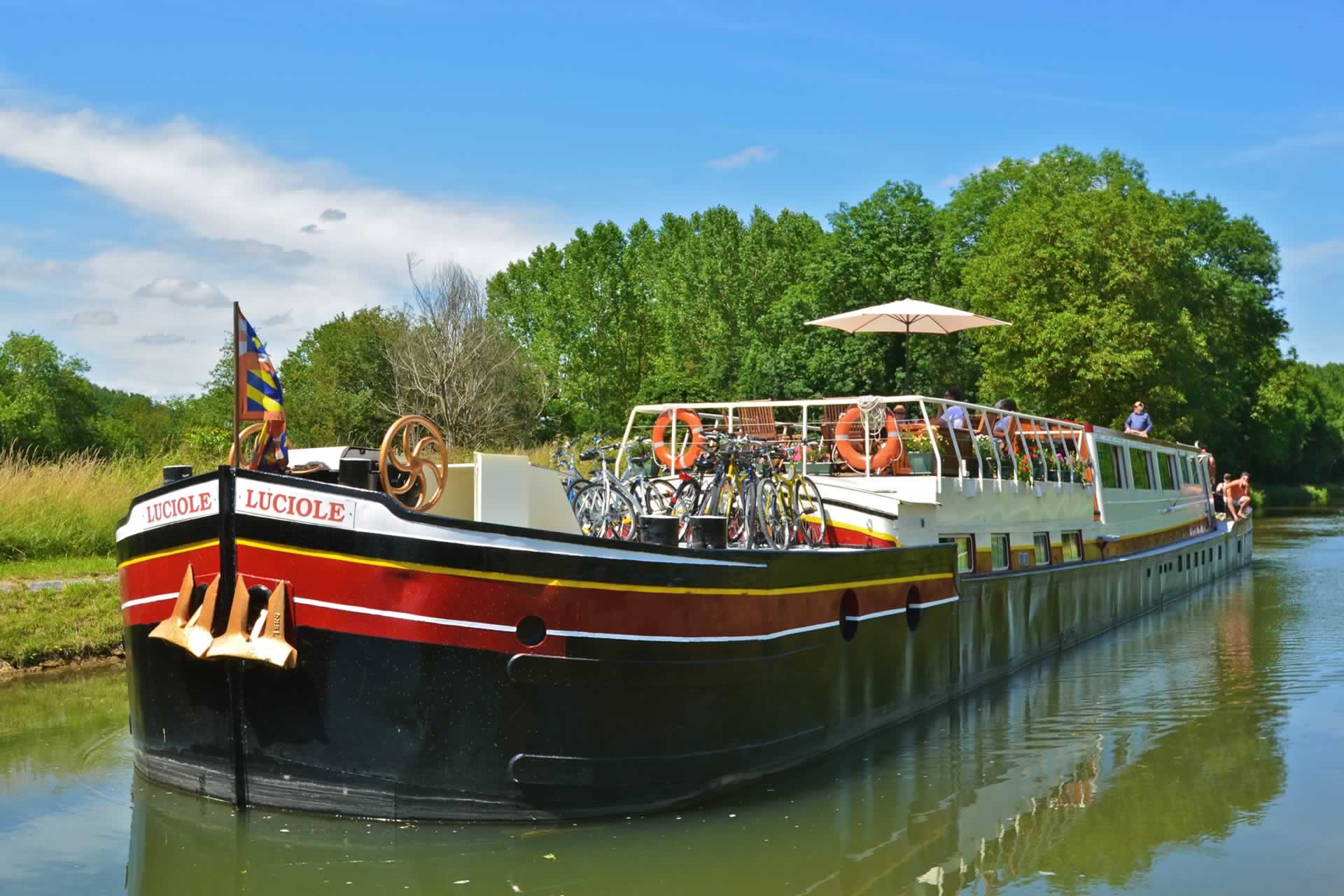- Previous
- |
- All articles
- |
- Next
Lock
On the British canals, a gently sloping wing wall guides your boat into the chamber. In ‘Bashville’, France, skippers of 130-ton barges have no such luxury…
As I write…
Articles often begin like that. This one, inevitably, will be published weeks after the event. No matter, it is real to me now. I am steering our barge Luciole again tomorrow, for the first time in nine months. Our Captain, Stephane, has been called away because of illness. I am his replacement.
One day I am behind a desk in Cheshire, pondering cash-flow and what to say to NatWest, the next I’m on Eurostar. The day after that I am meeting our 14 passengers, from Oregon, Arizona and New Zealand. They will be out on deck looking at me tomorrow as we approach the Ecluse de Batardeau, the first lock out of Auxerre. Will I get into it, or won’t I? It takes only a minute or so, usually, to get the hang of managing our barge again – except for the locks, where you need to have your eye in. It would be good to enter it smoothly. Batardeau, like maybe half on the climb up to Clamecy, is a lock off the River Yonne, with a current rolling across as we line up for the entrance. In this case there is around a barge length of still water before reaching the gates, sheltered by a spit of land. Higher up, there are some locks, St-Maur and Rechimet, for example, where the current runs closer. Before Clamecy, at Basseville (known as Bashville to the barging community), where the lock was built before people understood the problem, there is no still water at all.
Locks in France rarely have funnel-shaped entrances. Corners in unforgiving stone await the unwary while barges such as ours, with the intention of carrying as much cargo as they possibly could, were built of the thinnest metal their owners could get away with. It pays not to miss.
It may be easy to get the bow in, but the real objective is to get the rest to follow. It is essential, in other words, to go in straight. A terrible juddering results if not, amongst the worst things you can inflict on a barge, shaking the rivets and bending the plates. All of us have done this, but always with regret. Luciole, built of 5mm steel and weighing 130 tons is easier than the 250-ton 38-metre vessels that friends have to manage, but she still shows the scars.
I always imagine a line down the middle of the lock, coming out into the canal. Then, if there is a current, or a cross- wind blowing, the technique is to get the centre of the barge up-current – or up-wind – of it. By how much depends, of course, on practice; but, basically, the more you do so, within reason, the slower you need to go.
Speed is judged not by gazing forward, which is deceptive, but by a sideways look at the bank, imagining someone walking. Even a strolling pace can produce a dent.
An unfortunate characteristic of hotel-barges, as opposed to freighters, is that the steerer, or pilote, cannot see the bow. Too much superstructure lies in the way. People use mirrors, sometimes, but these can be confusing. With us a second crew member, the matelot usually, calls out a series of numbers from the deck alongside. “Zero” means we are going to skim the wall. “Minus one” is a nominal space to the bad. We aim to go in at “plus one”, which means in a lock 5.20 metres, or 17ft wide, with a barge of 5.05 metres beam, the gap at the side is around three inches. And we have to be straight!
The excitement comes where there are really sharp bends, as on the Canal de Bourgogne on the climb through Marigny-le-Cahouet. Or at Rivottes Lock on the Nivernais when coming down. There the wind, however mild elsewhere, musters itself for a surprise attack from the west, just when you thought it was easy.
Well, I got into Batardeau ok, and St-Maur, despite a healthy current after weeks of rain. Rechimet was fine too, but I missed at Basseville by “minus one point five”. We bounced in from that, not severely, but enough to bring the cook out to wave a ladle at me. With 35 locks to get through in the week – taking 15 minutes each, incidentally, as opposed to the chipmunk-like rapidity with which the locks are tackled in England – one miss like that is just about average.
Max, our matelot, was steering for some of this time, doing rather better than me, with no misjudgements at all. I shall aim to match his record on the way to Auxerre again. The forecast is for high winds (which catch the saloon, so the stern goes across more quickly than the bow). I look forward to the challenge.
- Previous
- |
- All articles
- |
- Next
Hotel barge Luciole
Cruising since 1976
Phone: 00 44 1625 576880
From USA: 011 44 1625 576880
Email: info@bargeluciole.com
23 Adlington Road, Bollington
SK10 5JT England
1-2 Quai de la Republique, Auxerre
89000 France
© Hotel Barge Luciole 2025



